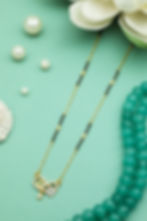Our Featured Collection: Where Dreams Take Form in Gold
Step into a world where artistry meets allure. Aadish Gold LLP proudly unveils our Featured Collection, a curated symphony of designs crafted to captivate your heart and elevate your style. Each piece is a testament to our legacy of innovation and luxury, meticulously brought to life to ensure you not only wear gold, but truly radiate it. Discover the perfect adornment that speaks to your soul, waiting to become a cherished part of your story.




Temple Antique Jewellery: A Legacy Adorned
Temple Antique Jewellery offers exquisite, handcrafted ornaments that pay homage to ancient Indian temple art. Each piece embodies India's rich cultural and spiritual heritage, meticulously crafted using traditional techniques. Our designs beautifully mirror deities, mythological figures, and architectural elements inspired by historic South Indian temples.These pieces hold profound significance beyond just their aesthetic appeal. They serve as tangible links to India's glorious past, preserving centuries of artistic evolution and cultural narratives, making them a true testament to our cultural heritage. Every piece showcases unparalleled skills, reflecting a legacy of Indian craftsmanship that we are proud to continue—a true display of artistic mastery. Furthermore, the motifs we incorporate, such as Lakshmiji, the Lotus, or the Peacock, carry deep symbolic meanings of prosperity, purity, or divine power. We craft these pieces with timeless elegance in mind, ensuring their classic beauty will be cherished for generations, often becoming treasured heirlooms passed down through families.
Mangalsutra: A Sacred Symbol of Love and Unity
The Mangalsutra holds a profound and cherished place in Indian tradition, transcending its function as a mere ornament. At its core, it is regarded as a sacred thread, a powerful emblem of commitment, marital bliss, and the enduring bond between the couple.
Deeply rooted in centuries of cultural practice, its design traditionally features black beads—believed to ward off negative energy and bring prosperity—interspersed with gold, culminating in a central gold pendant or 'Vati'. While its foundational elements remain timeless, our artisans craft modern interpretations of the Mangalsutra, elegantly blending these classic components with contemporary aesthetics. Today, you'll find designs ranging from minimalist and sleek to intricately detailed, ensuring it complements diverse personal styles while retaining its spiritual essence.
Ultimately, each Mangalsutra we create is designed to be more than just a piece of jewellery; it is a beautiful piece of art and a deeply personal representation of devotion.








Discover Our Gold Bali: A Curated Collection
We specialize in gold Bali, presenting a diverse collection that perfectly blends timeless appeal with contemporary trends, catering to a wide array of preferences and discerning market segments. Our extensive product offerings include radiant UV Bali, known for their unique light-catching finish that ensures striking brilliance and a modern aesthetic, and bold Salman Bali with their distinctive broad, flat surfaces that make a confident statement. We also craft gleaming Mirror Bali, recognized for their exceptional polish that beautifully reflects pure gold luster, intricate Fancy Bali featuring a wide array of innovative designs, and comfortable, yet substantial Pipe Bali, characterized by their hollow, tubular construction that offers a bold look without excessive weight. Each piece is meticulously produced to high standards in our state-of-the-art facilities, ensuring our collection consistently meets various market demands with superior quality.





